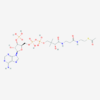Difference between revisions of "Acetyl-CoA"
| Line 1: | Line 1: | ||
{{MitoPedia | {{MitoPedia | ||
|description=[[File:Acetyl coenzyme A 700.png|left|100px|acetyl-CoA]]'''acetyl-CoA''', C<sub>23</sub>H<sub>38</sub>N<sub>7</sub>O<sub>17</sub>P<sub>3</sub>S, is a central piece in metabolism. It can be synthetized in | |description=[[File:Acetyl coenzyme A 700.png|left|100px|acetyl-CoA]]'''acetyl-CoA''', C<sub>23</sub>H<sub>38</sub>N<sub>7</sub>O<sub>17</sub>P<sub>3</sub>S, is a central piece in metabolism. It can be synthetized in different pathways: (i) in glycolysis from [[pyruvate]], by pyruvate dehydrogenase, which also forms NADH. (ii) from fatty acids β-oxidation, which releases one acetyl-CoA each round. (iii) catabolism of some aminoacids as leucine, lysine, phenylalanine, tyrosine and tryptophan.<br> | ||
Inside the mitochondria, acetyl-CoA is condensed with [[oxaloacetate]] to form [[citrate]] through the action of [[citrate synthase]] in [[tricarboxylic acid cycle]]. Acetyl-CoA cannot cross the mitochondrial inner membrane but citrate can be transported out of the mitochondria. In the cytosol, citrate can be converted to acetyl-CoA and be used in fatty acid, cholesterol, ketone bodies, acetylcholine synthesis, and other processes. | Inside the mitochondria, acetyl-CoA is condensed with [[oxaloacetate]] to form [[citrate]] through the action of [[citrate synthase]] in [[tricarboxylic acid cycle]]. Acetyl-CoA cannot cross the mitochondrial inner membrane but citrate can be transported out of the mitochondria. In the cytosol, citrate can be converted to acetyl-CoA and be used in fatty acid, cholesterol, ketone bodies, acetylcholine synthesis, and other processes. | ||
Revision as of 09:45, 14 October 2020
Description
acetyl-CoA, C23H38N7O17P3S, is a central piece in metabolism. It can be synthetized in different pathways: (i) in glycolysis from pyruvate, by pyruvate dehydrogenase, which also forms NADH. (ii) from fatty acids β-oxidation, which releases one acetyl-CoA each round. (iii) catabolism of some aminoacids as leucine, lysine, phenylalanine, tyrosine and tryptophan.
Inside the mitochondria, acetyl-CoA is condensed with oxaloacetate to form citrate through the action of citrate synthase in tricarboxylic acid cycle. Acetyl-CoA cannot cross the mitochondrial inner membrane but citrate can be transported out of the mitochondria. In the cytosol, citrate can be converted to acetyl-CoA and be used in fatty acid, cholesterol, ketone bodies, acetylcholine synthesis, and other processes.
Communicated by Cecatto Cristiane last update 2020-10-14
MitoPedia topics: Substrate and metabolite

